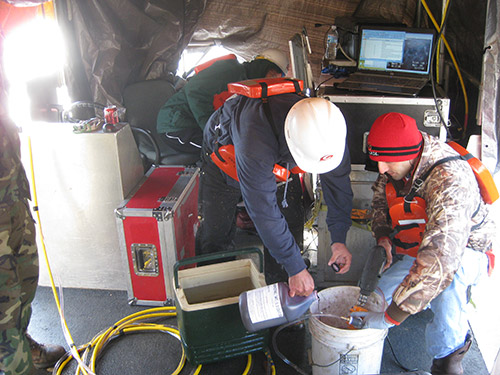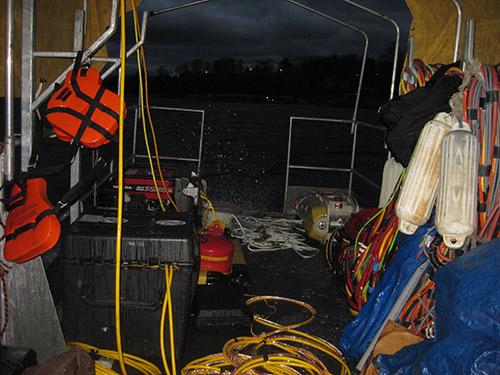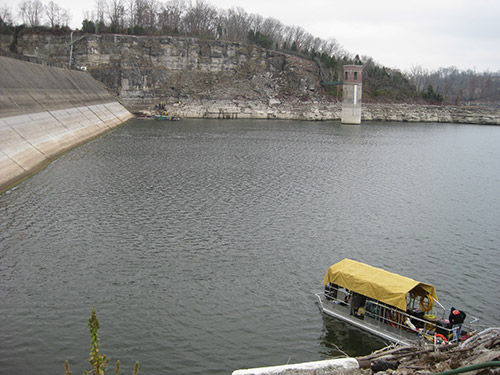Face of dam inspection and dye injection to determine flow rate and path through a dam
Hibbard Inshore was contacted by a customer to inspect several features, including a known leak on the face of the dam and to inject dye into the known leak. The known leak and debris on the face of dam identified by the customer posed significant risk of the Remotely Operated Vehicle (ROV) getting permanently caught underwater. To reduce this risk, Hibbard Inshore proposed bringing two ROVs to the project, so the second one could assist if there was a problem. Due its size and power, the Navajo ROV outfitted with both color and low-light monochrome cameras, two sonar heads, a manipulator and dye deployment mechanism was used. The dual sonar units – a sector scan (forward-looking) unit and a profiling (cross sectioning) unit – were used for navigation and dimensioning in low visibility situations.
 Hibbard Crew Preparing Dye for Injection
Hibbard Crew Preparing Dye for Injection
The first part of the face of dam inspection was to survey the leak to look for changes in character since the previous inspection and to identify any new potential hazards. In addition, Hibbard Inshore inspected a depression in the bottom near the intake of the dam to determine if there was flow through the dam at that point as well.
The ROV was deployed from a boat positioned about 20 feet off the face of dam. The ROV descended to the depth of the leak and followed up the face of dam to the leak location. Once the ROV had a visual confirmation on the leak area, the ROV operator turned on its scaling lasers to give a frame of reference for the speed that the particles were traveling.
 ROV on Boat for Deployment
ROV on Boat for Deployment
At that point, a pump was used to clear the air from the dye injection line and once the ROV was in proper position, 5 gallons of orange dye was pumped into the line. By utilizing the ROV for this task, it was assured that divers could remain away from the dangerous hazard and that the dye could be injected from a location very close to the crack. This ensured that the dye moved into the crack rather than elsewhere on the dam. After releasing the dye, the ROV continued inspecting the face of dam.
During the face of dam inspection, the ROV found many areas covered with trees and debris. In the areas not covered by debris, the ROV confirmed that the form lines, offset of slabs, the membrane and membrane bolt plates were consistent with drawings provided from the previous inspection.
 4 ROV Work Boat in Front of Dam Face
4 ROV Work Boat in Front of Dam Face
For the depression inspection, the ROV descended 171 feet, performed a visual inspection and took sonar snapshots for dimensioning purposed. No flow was detected the depression and no particulate was seen to be visibly entering the depression.
By utilizing an ROV, the face of dam inspection, depression inspection and the dye injection were completed with the same equipment and crew quickly and safely. The ROV’s flight path was managed in order to minimize risk to both itself and the dam allowing it to be easily retrieved at the conclusion of the project. From the data collected, the client was able to evaluate repair options and select a method of repair.

